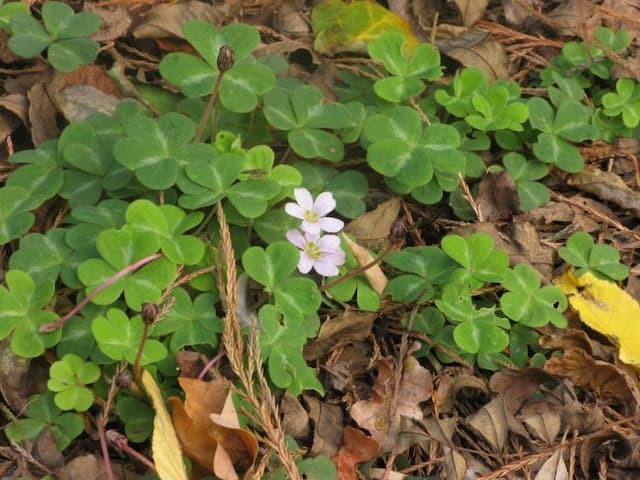Oca Oxalis tuberosa

ABOUT
Oxalis tuberosa, commonly known as oca, is a vibrant perennial plant that catches the eye with its clover-like foliage. The leaves boast a rich green color and are composed of three heart-shaped leaflets, which often have a purple underside, contributing to the plant's ornamental appeal. These leaves are borne on stems that can vary in color from green to red or purple, adding to the visual interest of the plant. The oca produces small, trumpet-shaped flowers that range in color from white to yellow or pink, and these blooms have a delicate, symmetrical appearance. Facilitating its appeal to pollinators, the flowers are a nectar source for bees and other insects. One of the most notable characteristics of the oca is its waxy, tuberous roots, which come in a variety of colors such as yellow, pink, purple, and orange. These tubers are knobby and can vary in shape, sometimes appearing elongated or with a spiraled twist. Their appearance is somewhat reminiscent of twisted sweet potatoes or brightly colored, knobby fingers stretching out from the soil. In gardens or farms, the oca's sprawling habit and its colorful leaves and tubers make it a unique and visually appealing addition, regardless of whether it's grown for ornamental purposes or as a food crop.
About this plant
 Names
NamesFamily
Oxalidaceae
Synonyms
Oca, New Zealand Yam, Andean Tuber, Cubio, Khawi, Papa Roja, Ibias, Quiba, Uqa
Common names
Oxalis crenata, Oxalis crinita, Ionoxalis crinita, Ionoxalis tuberosa, Oxalis tuberosa var. pilosa, Oxalis tuberosa var. subcrenata.
 Toxicity
ToxicityTo humans
Oxalis tuberosa, commonly known as oca, is not considered toxic to humans. This tuber is widely cultivated as an edible crop in many parts of South America and is consumed similarly to potatoes. However, like other members of the Oxalis genus, it contains oxalic acid. Consuming large amounts of oxalic acid can lead to nutritional deficiencies, particularly calcium deficiency, and in extreme cases, can cause kidney stones due to the formation of calcium oxalate crystals. Therefore, it is recommended to eat oca in moderation as part of a balanced diet.
To pets
Oca is not commonly reported to be toxic to pets, but given that it is a member of the Oxalis family, which are known to contain compounds like oxalic acid, it could potentially cause problems if ingested in large quantities. While consuming oca is unlikely to harm pets, the ingestion of significant amounts of plants containing oxalic acid can potentially lead to vomiting, diarrhea, or more severe symptoms such as kidney stones or kidney failure due to the formation of calcium oxalate crystals. Pets should not be encouraged to eat foods not specifically intended for their consumption. If a pet ingests a large amount of oca or any other plant containing oxalic acid, it is advisable to consult a veterinarian.
 Characteristics
CharacteristicsLife cycle
Perennials
Foliage type
Deciduous
Color of leaves
Green
Flower color
Yellow
Height
1 foot (30 cm)
Spread
1 foot (30 cm)
Plant type
Bulb
Hardiness zones
7
Native area
South America
Benefits
 General Benefits
General Benefits- Edible tubers: The tubers of Oxalis tuberosa, commonly known as Oca, are edible and considered a staple carbohydrate in parts of the Andean region.
- Nutritious: Oca tubers are rich in carbohydrates, vitamin C, and minerals such as iron and potassium.
- Low in calories: Compared to other staple tubers, Oca is low in calories, making it a suitable option for weight management diets.
- Diverse culinary uses: Oca can be eaten raw, cooked, or dried and has a tangy, lemony flavor that complements various dishes.
- Drought-resistant: Oca plants are drought-resistant and can grow in a variety of soil conditions, making them a reliable crop in challenging environments.
- Easy propagation: Oca is propagated through replanting the tubers, making it easy for farmers and gardeners to cultivate.
- Less prone to pests: Oca is not as susceptible to common pests that affect other tuber crops, thereby reducing the need for pesticides.
- Growth in marginal soils: Oca can grow in marginal soils where other staple crops may not thrive, enhancing food security.
 Medical Properties
Medical Properties- Anti-inflammatory: Oxalis tuberosa is believed to have anti-inflammatory properties which may help soothe inflammation.
- Antiscorbutic: The plant is a source of vitamin C and has been traditionally used to prevent and treat scurvy.
- Digestive Aid: It has been used in traditional medicine to aid digestion and alleviate stomach ailments.
 Air-purifying Qualities
Air-purifying QualitiesThis plant is not specifically known for air purifying qualities.
 Other Uses
Other Uses- Ocas (Oxalis tuberosa) can be used as a natural dye, offering a range of colors from yellows to reds depending on the mordant used.
- They serve as a traditional food crop in the Andes, known as a staple similar to potatoes and valued for their unique tangy flavor.
- Their flowers can be used for ornamental purposes, both in gardens and as part of floral arrangements due to their bright colors.
- Ocas leaves are edible and can be added to salads or cooked like spinach, providing a lemony flavor to dishes.
- They are often used in educational settings to demonstrate the process of tuberization and adaptation to high altitudes.
- The plant can act as a trap crop, drawing pests away from more valuable crops as part of an integrated pest management system.
- In some cultures, Ocas are used in rituals and ceremonies due to their vibrant colors and association with Andean heritage.
- They can be fermented to produce an alcoholic beverage similar to chicha, a traditional Andean drink.
- Their starchy tubers can be sun-dried and rehydrated later, offering a preserved food source that can last for years, known as 'khaya' in the Andes.
- The plant can contribute to soil health by being used as a green manure, enhancing soil structure and fertility.
Interesting Facts
 Feng Shui
Feng ShuiOca is not used in Feng Shui practice.
 Zodiac Sign Compitability
Zodiac Sign CompitabilityOca is not used in astrology practice.
 Plant Symbolism
Plant Symbolism- Productivity: Known as Oca, this plant grows vigorously and produces abundant tubers, embodying the principle of productivity in agriculture and life.
- Adaptability: Oca can thrive in different climates and altitudes, symbolizing the ability to adapt and prosper in diverse environments.
- Nutrition: As a nutritious food source, Oca signifies nourishment and the sustenance provided by the Earth.
- Endurance: Due to its resilience and ability to grow in harsh conditions, Oca represents endurance and the ability to overcome challenges.
- Cultural Heritage: Oca is an important crop in Andean culture, representing tradition, history, and the importance of maintaining cultural practices.
 Water
WaterThe Oca plant, commonly known as Oxalis tuberosa, prefers to be watered once the top inch of the soil has dried out. Typically, this means watering it once every week, but this frequency can increase during hot, dry periods or decreased during cooler, dormant seasons. When watering, apply enough water to moisten the soil throughout the pot, which can often mean about one to two gallons depending on the size of the plant and pot. Avoid letting the plant sit in standing water as this can lead to root rot.
 Light
LightOca plants thrive in bright, indirect sunlight but can tolerate partial shade. The best spot for an Oca plant would be near a window that gets plenty of light throughout the day but is shielded from direct midday sun, which could be too harsh and scorch the leaves.
 Temperature
TemperatureThe ideal temperature range for the Oca plant is between 60 to 75 degrees Fahrenheit. It can survive minimum temperatures down to around 50 degrees Fahrenheit and maximum temperatures up to 90 degrees Fahrenheit. However, prolonged exposure outside of the 60-75 degrees range may stress the plant and affect its growth.
 Pruning
PruningPruning the Oca plant is generally done to remove any dead or yellowing leaves and to maintain its shape. Prune sparingly, as needed, to promote healthy growth and appearance. The best time for pruning is during the early spring or after flowering if the plant appears leggy or overgrown.
 Cleaning
CleaningAs needed
 Soil
SoilOca (Oxalis tuberosa) thrives in well-draining soil with a mix of sand, loam, and organic matter such as compost. A slightly acidic to neutral soil pH of 5.5 to 7.0 is ideal for optimal growth.
 Repotting
RepottingOca should be repotted every 2 to 3 years to refresh the soil and accommodate tuber growth. It's best done in the late winter or early spring before new growth begins.
 Humidity & Misting
Humidity & MistingOca prefers moderate humidity levels but is quite adaptable and can tolerate the typical humidity found in most homes.
 Suitable locations
Suitable locationsIndoor
Keep oca in bright, indirect light and water when topsoil is dry.
Outdoor
Plant oca in partial shade, moist, fertile soil, and protect from frost.
Hardiness zone
7-11 USDA
 Life cycle
Life cycleOca (Oxalis tuberosa) begins its life as a tuber, which is planted in the soil where it sprouts and develops a root system and shoots. The shoots grow into stems with characteristic trifoliate leaves and the plant undergoes vegetative growth. During its growth period, it may produce small, inconspicuous yellow flowers, although the plant is primarily propagated through tuber division rather than seed production. As the growing season progresses, the tubers beneath the soil swell and multiply. Towards the end of the growing season as temperatures drop or daylight decreases, the above-ground foliage of oca begins to die back, signaling the plant's entry into a period of dormancy. The tubers are then harvested, and some can be saved to replant the following season, completing the cycle.
 Propogation
PropogationPropogation time
Spring-Early Summer
Propogation: Oca, also known as Oxalis tuberosa, is commonly propagated through tubers, which is the most popular method. The best time to propagate oca is in spring after the danger of frost has passed. Gardeners typically select healthy, mature tubers and cut them into pieces, ensuring each piece contains at least one eye, similar to the propagation of potatoes. These tuber segments are then planted about 1 to 3 inches deep (2.5 to 7.6 cm) and spaced approximately 12 to 15 inches (30 to 38 cm) apart in rows. The soil should be fertile, well-drained, and in a sunny location. As the plants grow, they can be earthed up in a manner akin to potato cultivation to encourage the formation of additional tubers. Care must be taken to keep the soil consistently moist but not waterlogged to avoid rotting of the tubers.




